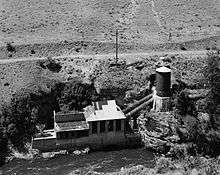Enloe Dam and Powerplant
| Enloe Dam | |
|---|---|
 Enloe Dam from downstream | |
| Location | Okanogan County, Washington |
| Coordinates | 48°57′57″N 119°30′03″W / 48.96583°N 119.50083°WCoordinates: 48°57′57″N 119°30′03″W / 48.96583°N 119.50083°W |
| Construction began | 1919 |
| Opening date | 1920 |
| Operator(s) | Okanogan County Public Utility District |
| Dam and spillways | |
| Type of dam | Concrete gravity arch |
| Impounds | Similkameen River |
| Height | 54 feet (16 m) |
| Length | 290 feet (88 m) |
| Width (crest) | 6 feet (1.8 m) |
| Width (base) | 41 feet (12 m) |
| Spillway type | Uncontrolled ogee overflow |
| Reservoir | |
| Total capacity | 507 acre feet (0.000625 km3) due to siltation |
| Power station | |
| Turbines | abandoned |
|
Enloe Dam and Powerplant | |
| Nearest city | Oroville, Washington |
| Area | 3 acres (1.2 ha) |
| NRHP Reference # | 78002764[1] |
| Added to NRHP | October 18, 1978 |
The Enloe Dam, also known as the Similkameen Dam, and its powerplant are located on the Similkameen River about 4 miles (6.4 km) west-northwest of Oroville, Washington. Located just above Similkameen (Coyote) Falls, the concrete arch-gravity dam stands about 54 feet (16 m) high, with a crest length of about 290 feet (88 m), built between 1916 and 1923. The dam was named after the president of the Okanogan Valley Power Company, Eugene Enloe. The dam was operated to generate power at its powerplant, located about 850 feet (260 m) downstream from the dam.[2]
History
The dam replaced a wood crib dam started in 1903 by J.M. Hagerty, a local entrepreneur, and completed a year after his death. The dam fed a generating plant in a wooden powerplant below the dam and falls. Power went to the towns of Nighthawk and Oroville, as well as the nearby Owasco, Ivanhoe, Ruby and Canba mines. Attempts by Hagerty's estate to sell the dam in 1913 met no interest, partly because of the poor state of the crib dam. Eugene Enloe of the Okanogan Valley Power Company was able to secure the rights to the site in 1916, hiring C.F. Uhden to design the dam that year. Construction did not start until 1919 and was completed in 1920 at a cost of $350,000, $150,000 of it Enloe's money. Enloe sold the dam and powerplant in 1923 to Washington Water Power Company, which added a second penstock.[3]
Description
The dam features an unregulated overflow spillway whose height can be augmented by flashboards. The powerplant replaced a small run-of-river plant, which received water from a diversion channel. In 1923, the site was purchased by the Washington Water Power Company. In 1942 the WWPC was purchased by the Okanogan Public Utility District, which then ceased operations at Enloe Dam in 1958, as power was available from the Bonneville Power Administration system[2] at less cost. The dam's reservoir extends 2 miles (3.2 km) up the Similkameen River. Largely silted up, it is just 9 feet (2.7 m) deep.[4] Storage capacity is only 507 acre feet (625,000 m3).[5]
The concrete powerhouse is in a partly ruinous state, and options have been presented to stabilize or demolish the structure when the proposed new hydroelectric development is undertaken.[6] The powerhouse was fed by two wood stave penstocks, 7 feet (2.1 m) in diameter, running to Pelton wheels driving two 1.6 megawatt generators. The generator hall stands next to a heavily built transformer vault.[3]
Redevelopment

The Okanogan Public Utility District obtained a new license for power generation from the Federal Energy Regulatory Commission in 1983, but the license was withdrawn in 1986 because the dam's impact on anadromous fish had not been addressed. A second license for a 4.1 megawatt plant was granted in 1996, but was again rescinded on the same grounds in 2000.[4] Yet another application was submitted in August 2008, seeking to build a new powerplant to generate 9 megawatts, fed by a new intake channel.[7]
Enloe Dam was listed on the National Register of Historic Places on October 18, 1978[1] as an example of early power development in rural Washington.
References
- 1 2 National Park Service (2010-07-09). "National Register Information System". National Register of Historic Places. National Park Service.
- 1 2 Vissia, Rod (November 12, 1974). "National Register of Historic Places Inventory - Nomination Form: Enloe Dam and Powerplant" (PDF). National Park Service. Retrieved 7 September 2011.
- 1 2 Holstine, Craig; Eminger, John (December 1990). "Enloe Dam". Historic American Engineering Record. Retrieved 7 September 2011.
- 1 2 "Enloe Dam". Center for Environmental Law and Policy. Retrieved 7 September 2011.
- ↑ "Exhibit A" (PDF). FERC Application: Enloe Dam and Powerplant. Okanogan County PUD. August 2008. Retrieved 7 September 2011.
- ↑ "Environmental Report" (PDF). FERC Application: Enloe Dam and Powerplant. Okanogan County PUD. August 2008. Retrieved 7 September 2011.
- ↑ "Enloe Hydroelectric Project". Okanogan County PUD. Retrieved 7 September 2011.
External links
| Wikimedia Commons has media related to Enloe Dam and Powerplant. |
- Historic American Engineering Record (HAER) No. WA-6, "Enloe Dam, On Similkameen River, Oroville vicinity, Okanogan County, WA"
- HAER No. WA-6-A, "Enloe Dam, Power House, On Similkameen River, Oroville vicinity, Okanogan County, WA"